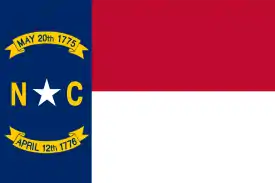List of North Carolina state legislatures
The North Carolina General Assembly of the U.S. state of North Carolina has convened many times since the state declared its independence from the British Crown and established a constitution in December 1776 during the Fifth North Carolina Provincial Congress.[1]
Part of a series on the |
|---|
| History of North Carolina |
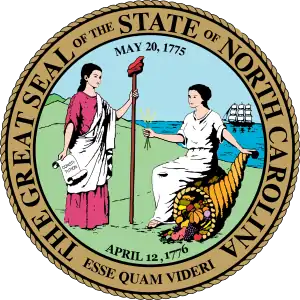 |
|
|
Prior to 1957, the General Assembly convened in January at a time fixed by the Constitution of North Carolina. From 1957 through 1967, sessions convened in February at a time fixed by the Constitution. The 1969 General Assembly was the first to convene on a date fixed by law after elimination of the constitutionally fixed date. The assembly now convenes on the third Wednesday after the second Monday in January after the November election.
History of the legislatures
The new General Assembly, which first convened in April 1777, consisted of a Senate, which had one member from each county (regardless of population), and a House of Commons, which had two members representing each county, plus one each from certain towns/districts.[2]
- Only protestant men owning land (100 acres for the House of Commons, 300 acres for the Senate) could serve. Early assemblies met in multiple locations in North Carolina when there was not a state capital.
- In 1789 at the Fayetteville Convention, the constitution was amended to substitute the word "Christian" for "Protestant". Fayetteville was also added as a borough/town.[3][4]
- In 1792, a commission was appointed to select a site to build a permanent state capital. The commission members favored land owned by Colonel John Hinton across the Neuse River, but the night before the final vote the committee adjourned to the home of Joel Lane in Wake County for an evening of food and spirits. The next day, the vote went in Lane's favor and the capital has been in Raleigh ever since.
- In the North Carolina Constitutional Convention of 1835, the constitution was amended to make the Governor elected by the people, but the legislature still elected all other officials. Amendments also set the number of senators at 50 and the number of commoners at 120. Senators would now be elected by districts representing approximately equal numbers of citizens, rather than by counties. Members of the House were still elected by county, but more populous counties were entitled to more representatives.[5][6][4][3]
- In 1868, a new constitution changed the name of the House of Commons to the House of Representatives. It also established the office of Lieutenant Governor. Previously, the Speaker of the Senate was the constitutional successor to the Governor in case of death or resignation. Property qualifications for holding office were also abolished. This constitution also established administrative townships in every county. The power to elect executive officers and judges was taken from legislators and given to the people in this session. The House of Commons was renamed as the House of Representatives. The Speaker of the Senate was abolished and the newly-created Lt. Governor became the President of the Senate when it was in session; next in line became the President Pro Tempore elected by members.[7][3]
- In 1868, African Americans were first elected to the General Assembly (fifteen representatives and two senators). But after Democrats consolidated power in the late 1890s, no African Americans were elected until Henry Frye (a Democrat) in 1968.
- Lillian Exum Clement became the first female member of the General Assembly in 1921
- The North Carolina Constitution was rewritten in 1971.[8]
Legislatures
The following table shows when and where the North Carolina General Assembly met. The numbered order indicates a new election.[1][9][2][10][11][12][13][14]
| Election Order | Assembly Link | Location | Dates of Sessions | Comments about assemblies and legislation[10][15][16] | |
|---|---|---|---|---|---|
| 1 | 1777 | New Bern |
|
This assembly probably met in the Tryon Palace after it was vacated by the British. Created Burke, Camden, Caswell, Nash, and Wilkes counties. Total of 38 counties and seven Districts were represented in the assembly. The assembly elected the Councilors of State. The governor was elected in the Fifth North Carolina Provincial Congress. | 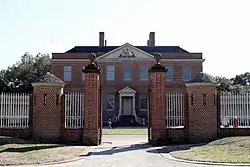 Tryon Palace |
| 2 | 1778 |
|
This assembly established the following counties in their last session in 1779: Franklin, Gates, Jones, Lincoln, Montgomery, Randolph, Richmond, Rutherford, Warren, and Wayne counties. The assembly elected the governor and councilors of state per the state constitution of 1776. | ||
| 3 | 1779 |
|
|
||
| 4 | 1780–1781 |
|
|
The journals for this assembly are missing.[18][19] | |
| 5 | 1781 | Wake Court House | June 23 – July 14, 1781 | The town of Wake Court House later became Bloomsbury, which is currently a historic district in Raleigh. | |
| 6 | 1782 | Hillsboro | April 15 – May 18, 1782 | ||
| 7 | 1783 | Hillsboro | April 18 – May 17, 1783 | This assembly created Davidson and Greene counties. | |
| 8 | April 1784 | New Bern | April 19 – June 3, 1784 | Davidson County and Greene County sent delegates to the NC General Assembly for the first time in 1784. During 1784, the assembly created Moore County and Sampson County. These two counties also sent delegates to the NC General Assembly for the first time in 1784. | |
| 9 | October 1784 | New Bern | October 25 – November 26, 1784 | ||
| 10 | 1785 | New Bern | November 19 – December 29, 1785 | During 1785, the assembly created Rockingham County. | |
| 11 | 1786 | Fayetteville | November 20, 1786 – January 6, 1787 | In 1786, Rockingham County sent its first delegates to the assembly. | |
| 12 | 1787 | Tarboro | November 19 – December 22, 1787 | During 1786, the assembly created Hawkins County and Sumner County. These two counties sent their first delegates to the NC General Assembly in 1787. During the earlier 1786/1787 session, the assembly created Robeson County, and its first delegates showed up later in the same session. | |
| 13 | 1788 | Fayetteville | November 3 – December 6, 1788 | This assembly created Iredell County and Tennessee County, North Carolina. | |
| 14 | 1789 | Fayetteville | November 2 – December 22, 1789 | Iredell and Tennessee counties sent their first delegates to the assembly. Fayettteville was added as a city/borough with a Senator. This General Assembly ceded the lands west of the Appalachian Mountains to the U.S. Government as part of North Carolina's national debt. This assembly elected the first two U.S. Senators from North Carolina and established a process for the people to elect five members to the U.S. House of Representatives in early 1790. This assembly established the University of North Carolina and appropriated funds for the initial buildings. | |
| 15 | 1790 | Fayetteville | November 1 – December 15, 1790 | During 1789, the assembly created Stokes County. In 1790, Stokes County sent its first delegates to the NC General Assembly. This was also the first General Assembly that allowed the Borough Town of Fayetteville to elect and send a delegate to the House of Representatives. Also during 1789, North Carolina ceded seven (7) counties on the western side of the Appalachian Mountains to the newly-established "Southwest Territory," which later became the state of Tennessee in 1796: Davidson, Greene, Hawkins, Sullivan, Sumner, Tennessee, and Washington. These seven counties no longer sent delegates to the NC General Assembly. | |
| 16 | 1791–1792 | New Bern | December 5, 1791 – January 19, 1792 | ||
| 17 | 1792–1793 | New Bern | November 15 – January 1, 1793 | During 1791, the assembly created four new counties: Buncombe, Glasgow, Lenoir, and Person. These four counties sent their first delegates to the NC General Assembly in 1792. | |
| 18 | 1793–1794 | Fayetteville | December 2, 1793 – January 11, 1794 | ||
| 19 | 1794–1795 | Raleigh | December 30, 1794 – February 7, 1795 | This was the first assembly to meet in the newly completed North Carolina State House in Raleigh. | 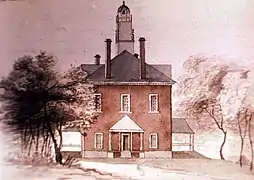 North Carolina State House (watercolor by Glennie) |
| 20 | 1795 | Raleigh | November 2 – December 9, 1795 | ||
| 21 | 1796 | Raleigh | November 21 – December 25, 1796 | ||
| 22 | 1797 | Raleigh | November 20 – December 23, 1797 | ||
| 23 | 1798 | Raleigh | November 19 – December 24, 1798 | ||
| 24 | 1799 | Raleigh | November 18 – December 23, 1799 | ||
| 25 | 1800 | Raleigh | November 17 – December 20, 1800 | During 1799, the assembly created two new counties: Ashe and Washington. Also in 1799, Glasgow County was renamed to Greene County. In 1800, these three counties sent their first delegates to the NC General Assembly. | |
| 26 | 1801 | Raleigh | November 16 – December 19, 1801 | ||
| 27 | 1802 | Raleigh | November 15 – December 18, 1802 | ||
| 28 | 1803 | Raleigh | November 21 – December 22, 1803 | ||
| 29 | 1804 | Raleigh | November 19 – December 19, 1804 | ||
| 30 | 1805 | Raleigh | November 18 – December 21, 1805 | ||
| 31 | 1806 | Raleigh | November 17 – December 21, 1806 | ||
| 32 | 1807 | Raleigh | November 16 – December 18, 1807 | ||
| 33 | 1808 | Raleigh | November 21 – December 23, 1808 | Jacob Henry was the first Jewish American in the assembly, serving in the House of Commons for Buncombe County. See also, Jacob Henry House.[20] | |
| 34 | 1809 | Raleigh | November 20 – December 23, 1809 | In 1808, the assembly created two new counties - Columbus and Haywood. Both sent new delegates to the General Assembly in 1809. | |
| 35 | 1810 | Raleigh | November 19 – December 22, 1810 | ||
| 36 | 1811 | Raleigh | November 18 – December 23, 1811 | This was the first General Assembly to meet in the newly renovated North Carolina State House in Raleigh. | 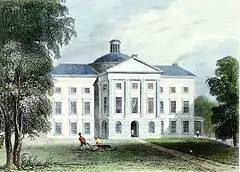 Renovated North Carolina State House (watercolor by William Goodacre) |
| 37 | 1812 | Raleigh | November 16 – December 25, 1812 | ||
| 38 | 1813 | Raleigh | November 15 – December 25, 1813 | ||
| 39 | 1814 | Raleigh | November 21 – December 27, 1814 | ||
| 40 | 1815 | Raleigh | November 20 – December 21, 1815 | ||
| 41 | 1816 | Raleigh | November 18 – December 28, 1816 | ||
| 42 | 1817 | Raleigh | November 17 – December 24, 1817 | ||
| 43 | 1818 | Raleigh | November 16 – December 26, 1818 | ||
| 44 | 1819 | Raleigh | November 15 – December 25, 1819 | ||
| 45 | 1820 | Raleigh | November 20 – December 25, 1820 | ||
| 46 | 1821–1822 | Raleigh | November 19, 1821 – January 1, 1822 | ||
| 47 | 1822 | Raleigh | November 18 – December 31, 1822 | ||
| 48 | 1823–1824 | Raleigh | November 17, 1823 – January 1, 1824 | In 1822, the assembly created Davidson County. In 1823, Davidson County sent their first delegates to the NC General Assembly. | |
| 49 | 1824–1825 | Raleigh | November 15, 1824 – January 5, 1825 | ||
| 50 | 1825–1826 | Raleigh | November 21, 1825 – January 4, 1826 | ||
| 51 | 1826–1827 | Raleigh | December 25, 1826 – February 12, 1827 | ||
| 52 | 1827–1828 | Raleigh | November 19, 1827 – January 7, 1828 | ||
| 53 | 1828-1829 | Raleigh | November 17, 1828 – January 10, 1829 | ||
| 54 | 1829–1830 | Raleigh | November 16, 1829 – January 8, 1830 | During 1828, the assembly created Macon County. In 1829, Macon County sent their first delegates to the NC General Assembly. | |
| 55 | 1830–1831 | Raleigh | November 15, 1830 – January 8, 1831 | ||
| 56 | 1831–1832 | Raleigh | November 21, 1831 – January 14, 1832 | ||
| 57 | 1832–1833 | Raleigh | November 18, 1832 – January 11, 1833 | ||
| 58 | 1833–1834 | Raleigh | November 18, 1833 – January 13, 1834 | 1832 assembly not listed. | |
| 59 | 1834–1835 | Raleigh | November 17, 1834 – January 10, 1835 | During 1833, the assembly created Yancey County. In 1834, Yancey County sent its first delegates to the NC General Assembly. | |
| 60 | 1835 | Raleigh | November 16 – December 22, 1835 | This was the last assembly to have representatives from Districts, i.e. Edenton, Fayetteville, Halifax, Hillsborough, New Bern, Salisbury, and Wilmington. | |
| 61 | 1836–1837 | Raleigh | November 21, 1836 – January 23, 1837 | Per the North Carolina Constitutional Convention of 1835, the House of Commons was authorized a total of one hundred-twenty (120) delegates. Each county was authorized a minimum of one (1) delegate, while the most populous counties were authorized four (4) delegates. Each delegate was elected for a two (2) year term of office. During the 1836 session, the assembly created Davie County, but it was not until 1842 that Davie County began sending delegates to the General Assembly. | |
| 62 | 1838–1839 | Raleigh | November 19, 1838 – January 8, 1839 | During the 1838 session, the assembly created Henderson County, but it was not until 1844 that Henderson County began sending delegates to the General Assembly. During the 1839 session, the assembly created Cherokee County, and they sent their first delegates to the 1840 General Assembly. | |
| 63 | 1840–1841 | Raleigh | November 16, 1840 – January 12, 1841 | This assembly was the first to meet in the newly constructed North Carolina State Capitol in Raleigh, which was built after the destruction of the North Carolina State House in 1831. Although it was created in 1838, according to most sources, Cherokee County began sending its delegate to the NC General Assembly during the 1840 session. No other county giving up a delegate in this session, so Cherokee County may not have actually been authorized to send a delegate during this session - or - the NC General Assembly proceeded with 121 delegates. During the 1841 session, the assembly created Caldwell County, Cleveland County, and Stanly County. Caldwell County began sending delegates to the NC General Assembly in 1842. Cleveland County and Stanly County began sending delegates to the NC General Assembly in 1844. | 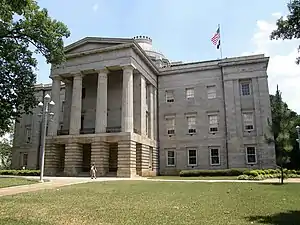 North Carolina State Capitol, completed in 1840 |
| 64 | 1842–1843 | Raleigh | November 21, 1842 – January 28, 1843 | Davie County was established in 1836, but it did not begin sending any delegates to the NC General Assembly until 1842. Caldwell County was established in 1841, and it began sending its delegates to the NC General Assembly in 1842. During 1842, the assembly created Catawba County, McDowell County, and Union County. McDowell County sent its first delegates to the NC General Assembly in 1852. Catawba County and Union County began sending their first delegates to the NC General Assembly in 1854. | |
| 65 | 1844–1845 | Raleigh | November 18, 1844 – January 10, 1845 | The reapportioning of the North Carolina House of Commons based upon the 1840 US Census was finally completed and implemented this year, and there were plenty of changes. With the creation of new counties since the last reapportionment, many existing counties had to give up one delegate to retain the number of members as stipulated in the latest NC State Constitution (120). However, Cabarrus County added one delegate. Although Henderson County was established in 1838, and Cleveland County and Stanly County were established in 1841, all three began sending their first delegates to the NC General Assemby in 1844. | |
| 66 | 1846–1847 | Raleigh | November 16, 1846 – January 18, 1847 | ||
| 67 | 1848–1849 | Raleigh | November 20, 1848 – January 27, 1849 | Although Catawba County was established in 1842, it did not begin sending its first delegates to the General Assembly until 1848. | |
| 68 | 1850–1851 | Raleigh | November 18, 1850 – January 29, 1851 | ||
| 69 | 1852 | Raleigh | October 4 – December 27, 1852 | ||
| 70 | 1854–1855 | Raleigh | November 20, 1854 – February 16, 1855 | Although McDowell County and Union County were established in 1842; Gaston County was established in 1846; Alexander County was established in 1847; Alamance, Forsyth, and Watauga Counties were established in 1849; Yadkin County was established in 1850; and, Jackson County and Madison County were established in 1851; all ten counties began sending their first delegates to the General Assembly in 1854. | |
| 71 | 1856–1857 | Raleigh | November 17, 1856 – February 3, 1857 | In 1856, the Assembly eliminated the requirement to own property in order to vote; however, only tax payers could vote.[21][3] | |
| 72 | 1858–1859 | Raleigh | November 15, 1858 – February 17, 1859 | ||
| 73 | 1860–1861 | Raleigh | November 19, 1860 – February 25, 1861. | Extra Session: May 1, 1861 – May 13, 1861. Extra Session: August 15, 1861 – September 23, 1861 This General Assembly decided that each county should vote for special delegates who would decide whether North Carolina should secede from the Union. On May 20, 1861, those special delegates convened in Raleigh and voted unanimously that the state would no longer be a part of the United States of America.[3] | .svg.png.webp) Flag of North Carolina (1861–1865) |
| 74 | 1862–1864 | Raleigh | November 17 – December 22, 1862 | Extra Sessions: January 19 – February 12, 1863; June 30 – July 7, 1863; November 23 – December 14, 1863; and May 17–30, 1864. | |
| 75 | 1864–1865 | Raleigh | November 21 – December 23, 1864 | Extra Sessions: January 17 – February 7, 1865 and May 17–28, 1865. | |
| 76 | 1865–1866 | Raleigh | November 27 – December 18, 1865. | Extra Session: January 18 – March 12, 1866 This was the first General Assembly to meet after the US Civil War, and Reconstruction was just beginning. Although Harnett County had been established in 1855, it was not until 1865 that Harnett County sent their first delegates to the NC General Assembly. As a result, Cumberland County had to give up one member in the House of Commons. | |
| 77 | 1866–1867 | Raleigh | November 19 – December 24, 1866 | Extra Session: January 22 – March 4, 1867 On March 4, 1867, the Reconstruction Acts of the U.S. Congress stipulated that North Carolina would be part of the Second Military District until they ratified the 14th Amendment. | |
| 78 | 1868–1869 | Raleigh | November 16, 1868 – April 12, 1869 | The House of Commons was renamed the House of Representatives. The assembly had extra Session from July 1 to August 24, 1868, in which they ratified the 14th Amendment. Although they had been established several years earlier, the following counties sent their first delegates to the 1868 General Assembly: Alleghany, Clay, Mitchell, Polk, Transylvania, and Wilson. This was the first assembly to have Black members in the house and senate. North Carolina was re-admitted to the Union on July 4, 1868 when they ratified the 14th Amendment. | |
| 79 | 1869-1870 | Raleigh | November 15, 1869 – March 28, 1870 | ||
| 80 | 1870–1872 | Raleigh | November 21, 1870 – April 6, 1871 | Extra Session: November 20, 1871 – February 18, 1872. Governor William Woods Holden was impeached by the House on December 14, 1870 and convicted by the Senate on March 22, 1871. Governor Holden was the first governor to be convicted and removed from office in the United States. | |
| 81 | 1872–1874 | Raleigh | November 18, 1872 – March 3, 1873 | Extra Session: November 17, 1873 – February 16, 1874 Dare County and Swain County sent their first delegates to this General Assembly. | |
| 82 | 1874–1875 | Raleigh | November 16, 1874 – March 22, 1875 | ||
| 83 | 1876–1877 | Raleigh | November 20, 1876 – March 12, 1877 | Pender County was established in 1875, and it sent their first delegates to the 1876 NC General Assembly. As a result, New Hanover County had to give up one member in the House of Representatives. | |
| 84 | 1879–1880 | Raleigh | January 8, 1879 – March 14, 1879 | Extra Session: March 15 – March 29, 1880. | |
| 85 | 1881 | Raleigh | January 5 – March 14, 1881 | Durham County was established in 1881 and it sent their first delegates to this NC General Assembly. Orange County had to give up one member of the House of Representatives as a result. | |
| 86 | 1883 | Raleigh | January 3 – March 12, 1883 | Although Graham County and Pamlico County were established in 1872, and Vance County was established in 1881, all three sent their first delegates to the 1883 NC General Assembly. | |
| 87 | 1885 | Raleigh | January 7 – March 11, 1885 | ||
| 88 | 1887 | Raleigh | January 5 – March 7, 1887 | ||
| 89 | 1889 | Raleigh | January 9 – March 11, 1889 | ||
| 90 | 1891 | Raleigh | January 7 – March 9, 1891 | ||
| 91 | 1893 | Raleigh | January 4 – March 6, 1893 | ||
| 92 | 1895 | Raleigh | January 9 – March 13, 1895 | ||
| 93 | 1897 | Raleigh | January 6 – March 9, 1897 | ||
| 94 | 1899–1900 | Raleigh | January 4 – March 8, 1899 | ||
| 95 | 1901 | Raleigh | January 9 – March 15, 1901 | Scotland County was established in 1899 and it sent their first delegates to the 1901 General Assembly. As a result, Richmond County had to give up one member in the House of Representatives. | |
| 96 | 1903 | Raleigh | January 7 – March 9, 1903 | ||
| 97 | 1905 | Raleigh | January 4 – March 6, 1905 | ||
| 98 | 1907–1908 | Raleigh | January 9-March 11 | Extra Session: January 21 – February 1, 1908. | |
| 99 | 1909 | Raleigh | January 6 – March 9, 1909 | ||
| 100 | 1911 | Raleigh | January 4 – March 8, 1911 | ||
| 101 | 1913 | Raleigh | January 8 – March 12, 1913 | Extra Session: September 24, 1913 Although Lee County was established in 1907, and Avery County and Hoke County were established in 1911, all three began sending their first delegates to this General Assembly. | |
| 102 | 1915 | Raleigh | January 6 – March 9, 1915 | ||
| 103 | 1917 | Raleigh | January 3 – March 7, 1917 | ||
| 104 | 1919–1920 | Raleigh | January 8 – March 11, 1919 | Extra Session: August 10–26, 1920. | |
| 105 | 1921 | Raleigh | January 5 – March 9, 1921 | First female representative in the House of Representatives, Lillian Exum Clement. | .jpg.webp) Rep. Lillian Exum Clement |
| 106 | 1923–1924 | Raleigh | January 3 – March 6, 1923 | Extra Session: August 7–23, 1924. | |
| 107 | 1925 | Raleigh | January 7 – March 10, 1925 | ||
| 108 | 1927 | Raleigh | January 5 – March 9, 1927 | ||
| 109 | 1929 | Raleigh | January 9 – March 19, 1929 | ||
| 110 | 1931 | Raleigh | January 7 – May 27, 1931 | Gertrude Dills McKee was the first female Senator. | |
| 111 | 1933 | Raleigh | January 4 – May 15, 1933 | ||
| 112 | 1935–1936 | Raleigh | January 9 – May 11, 1935 | Extra Session: December 10–16, 1936. | |
| 113 | 1937–1938 | Raleigh | January 6 – March 23, 1937 | Extra Session: March 8 – August 13, 1938. | |
| 114 | 1939 | Raleigh | January 4 – April 4, 1939 | ||
| 115 | 1941 | Raleigh | January 8 – March 15, 1941 | ||
| 116 | 1943 | Raleigh | January 6 – March 10, 1943 | ||
| 117 | 1945 | Raleigh | January 3 – March 12, 1945 | ||
| 118 | 1947 | Raleigh | January 8 – April 5, 1947 | ||
| 119 | 1949 | Raleigh | January 5 – April 23, 1949 | ||
| 120 | 1951 | Raleigh | January 3 – April 14, 1951 | ||
| 121 | 1953 | Raleigh | January 7 – April 30, 1953 | ||
| 122 | 1955–1956 | Raleigh | January 5 – May 26, 1955 | Extra Session: July 23–27, 1956. | |
| 123 | 1957 | Raleigh | February 6 – June 12, 1957 | ||
| 124 | 1959 | Raleigh | February 4 – June 20, 1959 | ||
| 125 | 1961 | Raleigh | February 8 – June 22, 1961 | This General Assembly was the last to meet in the North Carolina State Capital building in Raleigh. | |
| 126 | 1963 | Raleigh | February 6 – June 26, 1963 | This was the first assembly to meet in the newly completed North Carolina State Legislative Building in Raleigh. | .jpg.webp) North Carolina Legislative Building, completed in 1963 |
| 127 | 1965–1966 | Raleigh | February 3 – June 17, 1965 | Extra Session: November 15–17, 1965. Second Extra Session: January 10–14, 1966. | |
| 128 | 1967 | Raleigh | February 8 – July 6, 1967 | ||
| 129 | 1969 | Raleigh | January 15 – July 2, 1969 | ||
| 130 | 1971 | Raleigh | January 13 – October 30, 1971 | ||
| 131 | 1973–1974 | Raleigh |
|
Beginning at this General Assembly, the assembly met in both years from henceforth. | |
| 132 | 1975–1976 | Raleigh |
|
||
| 133 | 1977–1978 | Raleigh |
|
||
| 134 | 1979–1980 | Raleigh |
|
||
| 135 | 1981–1982 | Raleigh |
|
Extra Sessions: October 29–30, 1981; February 9–11, 1982; June 2–28, 1982. | |
| 136 | 1983–1984 | Raleigh |
|
Extra Session: August 26, 1983 (one day). | |
| 137 | 1985–1986 | Raleigh |
|
||
| 138 | 1987–1988 | Raleigh |
|
||
| 139 | 1989–1990 | Raleigh |
|
Extra Session: December 7, 1989 (one day). | |
| 140 | 1991–1992 | Raleigh |
|
Extra Session: December 30, 1991 – February 3, 1992. | |
| 141 | 1993–1994 | Raleigh |
|
Extra Session February 8 – March 26, 1994. | |
| 142 | 1995–1996 | Raleigh |
|
Daniel F. McComas was the first Hispanic member of the House of Representatives. Extra Session: February 21, 1996 (one day). | |
| 143 | 1997–1998 | Raleigh |
|
Extra Session: March 24 – April 30, 1998. | |
| 144 | 1999–2000 | Raleigh |
|
Extra Session: December 15–16, 1999. | |
| 145 | 2001–2002 | Raleigh |
|
Beverly Eaves Perdue was the first North Carolina Lieutenant Governor and President of the Senate. Extra Session: May 14 – November 26, 2002. | |
| 146 | 2003–2004 | Raleigh |
|
Extra Sessions: November 24–25, 2003; December 9–10, 2003; November 4, 2004 (one day). | |
| 147 | 2005–2006 | Raleigh |
|
||
| 148 | 2007–2008 | Raleigh |
|
Extra Sessions: September 10–11, 2007; March 20, 2008 (one day). | |
| 149 | 2009–2010 | Raleigh |
|
||
| 150 | 2011–2012 | Raleigh |
|
Extra Session: January 4 – February 18, 2012. | |
| 151 | 2013–2014 | Raleigh |
|
Extra Session: September 3–4, 2013. | |
| 152 | 2015–2016 | Raleigh |
|
||
| 153 | 2017–2018 | Raleigh |
|
||
| 154 | 2019–2020 | Raleigh | January 9 – July 12, 2019[2] | ||
| 155 | 2021–2022 | Raleigh | January 13 – |
Conventions
Several state conventions were held to ratify state and national constitutions:[1][10]
- 1788, Hillsborough Convention, United States Constitution
- 1789, Fayetteville Convention, U.S. Constitution
- 1835, North Carolina Constitutional Convention of 1835 in Raleigh
- 1861 Convention
- First Session, Raleigh, May 20-June 28, 1861
- Second Session, Raleigh, November 18-December 18, 1861
- Third Session, Raleigh, January 20-February 26, 1862
- Fourth Session, Raleigh, April 21-May 13, 1862
- 1865 Convention
- First Session, Raleigh, October 2-October 19, 1865
- Second Session, Raleigh, May 24-June 25, 1866
- 1868 Convention, Raleigh, January 14-March 17, 1868
- 1875 Convention, Raleigh, September 6-October 11, 1875
References
- Connor, R.D.D. (1913). A Manual of North Carolina (PDF). Raleigh: North Carolina Historical Commission. p. 453–. Retrieved April 27, 2019.
- "North Carolina General Assembly". Ballotpedia.org. Retrieved March 22, 2019.
- "North Carolina Constitution and Amendments". NHINET.ORG. Retrieved October 3, 2019.
- Orth, John V. (2006). "State Constitution". NCPedia. Retrieved April 29, 2019.
- Connor, Henry Groves (1908). "North Carolina Constitution of 1835". DOCSouth. Retrieved April 29, 2019.
- Humber, John L. (2006). "North Carolina Constitution of 1835". NCPedia. Retrieved April 29, 2019.
- "North Carolina Constitution of 1868" (PDF). North Carolina Legislature. Retrieved April 29, 2019.
- "North Carolina Constitution". North Carolina General Assembly. Retrieved April 29, 2019.
- Wheeler, John H. (1874). "The Legislative Manual and Political Register of the State of North Carolina". Retrieved April 9, 2019.
- John L. Cheney Jr., ed. (1975). North Carolina Government, 1585-1974, A Narrative and Statistical History.
- Lewis, J.D. "North Carolina General Assemblies, 1800s". Carolana.com. Retrieved November 28, 2019.
- Lewis, J.D. "North Carolina General Assemblies, Early Statehood". Carolana.com. Retrieved November 28, 2019.
- Lewis, J.D. "North Carolina General Assemblies, 1900s". Carolana.com. Retrieved November 28, 2019.
- Lewis, J.D. "North Carolina General Assemblies, 2000s". Carolana.com. Retrieved November 28, 2019.
- Lewis, J.D. "Historical Documents of the Legislative Branch". Carolana.com. Retrieved October 11, 2019.
- See, also, articles on each assembly for additional references.
- Uncertain, but Governor Abner Nash was elected in April 1780, so session was started.
- "Session Laws: North Carolina". HeinOnline. New York: William S. Hein & Co., Inc. Retrieved March 22, 2019. (subscription required)
- Lewis, J.D. "NC Revolution State House 1780". The American Revolution in North Carolina. Retrieved April 27, 2019.
- Cotten, Alice R. (1988). "Jacob Henry". NCPEDIA. Retrieved November 26, 2019.
- Stanley L. Engerman (2005). "The Evolution of Suffrage Institutions in the New World" (PDF). Retrieved October 3, 2019.
- "When is the General Assembly in Session?". ncleg.gov. Retrieved November 26, 2019.
External links
- "North Carolina Legislative History". University of North Carolina Law Library.
Research guide about resources and strategies for researching North Carolina legislative history
- "North Carolina Resources: Statutes & Legislation". Research Guides: U.S. States. Georgetown University Law Library.
